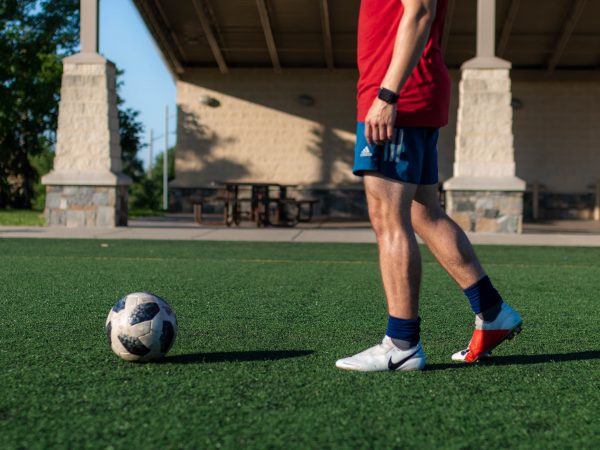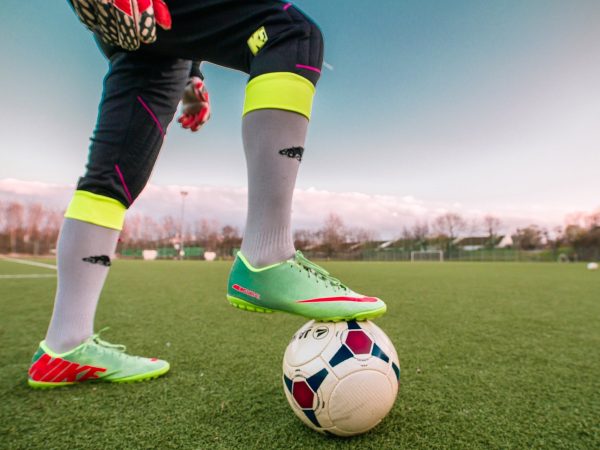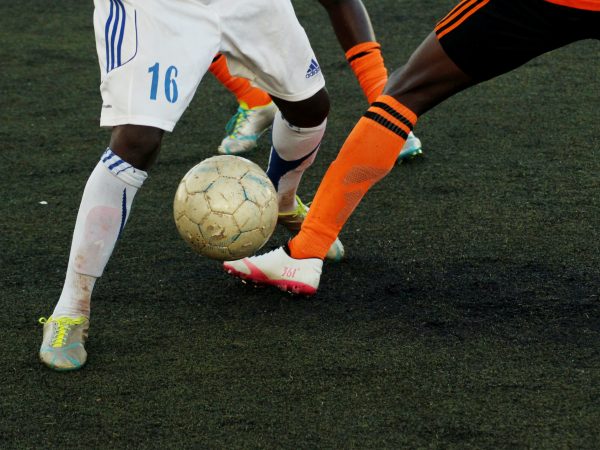PITCHING
A normal football field looks like this. At each end of the field, there is a centre circle and two penalty boxes. Each penalty box has a penalty spot and a 6-yard box. Although no two pitches are the same length or width, they must all be between 90 and 120 metres long and 45 to 90 metres wide. The penalty box measures 16m by 40m and has a 9m radius around the centre circle. Goalposts are located at each end of the field, with the penalty spot 11 metres (12 yards) in front of them.
THE INVOLVED PARTICIPANTS
On the pitch, each team has 11 players, with substitutions on the sidelines for both teams. Although there is no standard formation for the players on the pitch, a 4-4-2 formation with four defenders, four midfielders, and two forwards is typical.
The diagram below depicts a typical lineup. Players are free to travel around the field despite the fact that a team may adopt this arrangement. To confuse the defence, the wingers regularly switch sides.
There are a few common positions that aren’t shown in the diagram.
Center Defensive Midfield is the abbreviation for Center Defensive Midfield. These players play in the midfield but are defensively inclined, so be sure to sit back a little more when the ball is played forward. These are usually playmakers who can also tackle effectively.
Center Attacking Midfield is abbreviated as CAM. These players play central midfield as well, but they are more attack-minded, making them excellent goal scorers.
RWB vs. LWB: Which is Better?
The backs of the right and left wings, respectively. These are the defenders who prefer running up the wing and participating in the game. Because they are still defenders, they must rush back quickly if a counter-attack is launched.
Right Wing and Left Wing, respectively, are abbreviated as RW/LW. These are attacking positions, though in a 4-3-3 system, these players usually play out wide on the wing, allowing them to race up the wing before cutting inside or crossing the ball to the striker waiting in the middle.
The abbreviation CF stands for centre forward. This position is essentially comparable to that of a striker, with the exception that he moves somewhat more forward towards the goal and does not have to stay in a set region of the field.
THE GROUNDRUNNING PRINCIPLES
The purpose of the game is to kick the ball into your opponent’s goal while still defending your own. A player can throw the ball to anyone on the field and even run with it, unlike in several sports. There are only a few rules to follow when it comes to passing. The offside rule is the first, and it will be covered later down. When the goalkeeper is transferred back to you, the next one begins. If you pass the ball to your keeper with your feet, he must also play with his feet. If you head the ball back to him, he is free to pick it up.
etiquette for when you’re in a hurry
The ball is kicked off from the centre area at the start of each half and after a team score. It used to be that you had to pass the ball forwards before passing it backwards, but that no longer applies.
No players are allowed in the opposition half when the ball is kicked off.
Any foul can result in a free kick or a penalty if it happens in the penalty area. There may be free kicks in the region if the conditions are right.
When the attacking team kicks the ball beyond the goal line, it is called a goal kick. If the defending team kicks it behind their own line, the attackers get a corner kick.
Tackling is the ability to take the ball away from the players’ feet. It’s critical to make contact with the ball during tackling. If you make contact with the player rather than the ball, it’s a foul. When tackling, avoid lunging with both feet in the air to avoid injuring another player. You’ll be penalised for a foul if you elbow, tug on the player’s jersey, or shove them.
A goal kick must be taken on the 6-yard box’s edge, but a defender or the goalie can take it. A corner kick is when the attacking team places the ball in a little quarter-circle in a corner.
There are numerous types of fouls, however the following are a few to avoid. Dangerous Obstacles: Even if you don’t make touch with anyone, a referee may give a free kick.
You can contact the ball with your feet, head, chest, thighs, and even shoulder in handball, but not with your arm. Diving/Simulation: The referee has the authority to grant you a free kick if you pretend to be fouled.
Offside: This is not a foul that results in a booking, but it does give the opposing team a free kick. Physical violence: Anyone who starts or engages in a fight might be penalised by the referee (even if they did not start it).
Another non-bookable offence that is quite easy to avoid is the foul throw. Keep the ball behind your head until you’re ready to chuck it when throwing it in from the sidelines.









